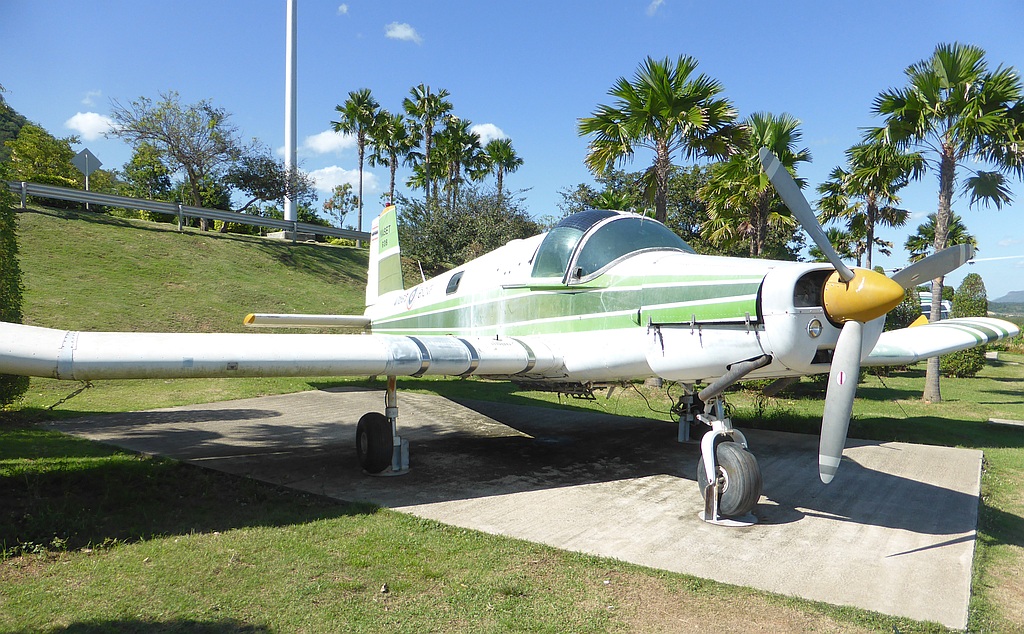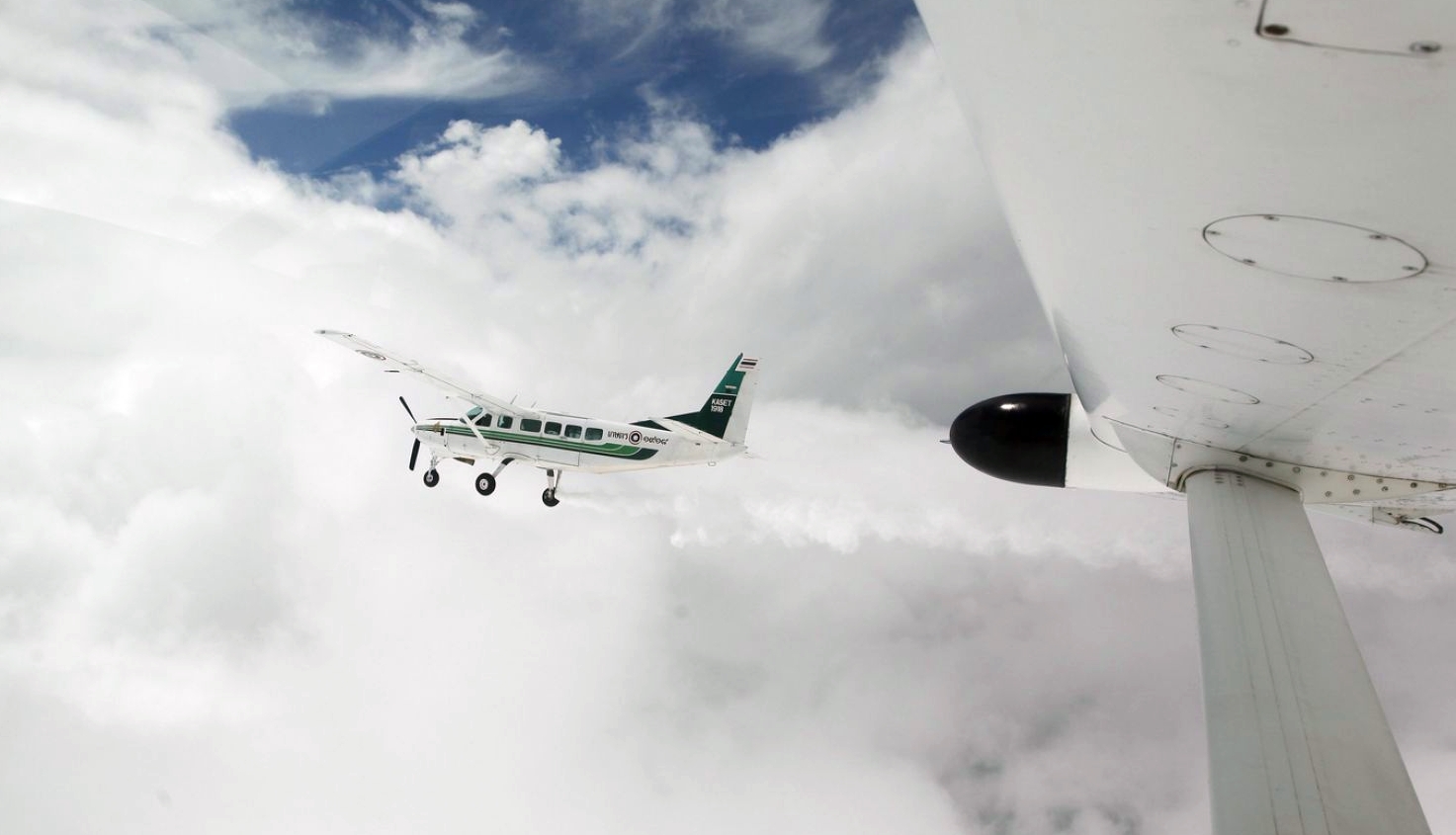
เราจะทำแบบวิศวกรผู้ยิ่งใหญ่
26. April 2024
Your valuable opinion :
Tags :
RoyalProjectsRainMaking.php 9879 Bytes 23-04-2024 05:43:55
 |
★★★ Royal Projects ★★★Rain Making Project - ฝนหลวง |
The Rain Making Project - a remedy against drought. This project was initiated in November 1955 by H.M. King Bhumibol Adulyadej
because over 82 percent of Thai agricultural land relied on rainfall - and therefore suffered the effects of drought.

The very first plane, to be seen at Chang Hua Man.
✈ Motivation
In 1955, His Majesty visited his subjects in the northeast. When passing the Phuphan Mountain Range, His Majesty saw that drought had
increased in frequency and severity because of seasonal changes and deforestation in the region. Environmental conditions from ground
level up to the cloud base were not conducive to water vapor condensation that would form clouds and precipitate, bringing rain.
His Majesty observed that there were a lot of clouds in the sky but no precipitation. Rainfall in the area had been less than normal,
sometimes not at all. Long dry spells were the result even though the southwest monsoon, the rainy season, had begun.
Source : Thailand Sustainable Development Foundation
Source : Thailand Sustainable Development Foundation
✈ Experimentation & Optimisation
As with other bigger projects it is wise to do a research on published papers, first. So did His Majesty and began to study artificial rainmaking
techniques to seek ways of bringing down more rain to ease the drought situation. He read research work on meteorology and weather modification,
which he found useful for influencing a weather change. A lot of experiments were conducted thereafter to verify the theory and optimise the
procedure.
On November 14th, 1955, His Majesty donated his private funds to launch the Royal Rainmaking Project, and he devoted a great deal of time and energy to develop rainmaking technology. Later, he entrusted M.R. Debariddhi Devakula, an expert in agricultural engineering at the Ministry of Agriculture and Cooperatives, to undertake research into rainmaking. M.R. Debariddhi conducted intensive research and experimentation over several years from various models applied by various countries, e.g. Australia and Israel. After initial research, the first practical experiment took place over a mountain barrier at Khao Yai National Park in Nakhon Ratchasima Province in July 1969, supervised by His Majesty, with Mom Rajawongse (M.R.) Debariddhi Devakula, an expert in agricultural engineering, as an assistant. The operation used light aircraft and seeded clouds with dry ice, or solid carbon dioxide. His Majesty had personally devised chemical formulae for seeding clouds in the rainmaking process. The first attempt at artificial rainmaking was successful; the clouds turned grey and rain did fall. However, there was no way to ensure that rain fell on a specific area. Further experiments were carried out in Hua Hin District, Prachuap Khiri Khan Province, with rainfall in target areas.
Source : Foreign Office, The Government Public Relations Department
Further reading : Weather Modification by Royal Rainmaking Technology
On November 14th, 1955, His Majesty donated his private funds to launch the Royal Rainmaking Project, and he devoted a great deal of time and energy to develop rainmaking technology. Later, he entrusted M.R. Debariddhi Devakula, an expert in agricultural engineering at the Ministry of Agriculture and Cooperatives, to undertake research into rainmaking. M.R. Debariddhi conducted intensive research and experimentation over several years from various models applied by various countries, e.g. Australia and Israel. After initial research, the first practical experiment took place over a mountain barrier at Khao Yai National Park in Nakhon Ratchasima Province in July 1969, supervised by His Majesty, with Mom Rajawongse (M.R.) Debariddhi Devakula, an expert in agricultural engineering, as an assistant. The operation used light aircraft and seeded clouds with dry ice, or solid carbon dioxide. His Majesty had personally devised chemical formulae for seeding clouds in the rainmaking process. The first attempt at artificial rainmaking was successful; the clouds turned grey and rain did fall. However, there was no way to ensure that rain fell on a specific area. Further experiments were carried out in Hua Hin District, Prachuap Khiri Khan Province, with rainfall in target areas.
Source : Foreign Office, The Government Public Relations Department
Further reading : Weather Modification by Royal Rainmaking Technology

Fattening the clouds, courtesy of : Bureau of The Royal Household, สำนักพระราชวัง.
✈ Outlook
The success of artificial rainmaking drew global attention and brought in requests for knowledge-sharing from several Asian countries. The calling has been
pronounced as far as the Middle East, where farmers suffer from arid climates and extremely long periods of dry season. Jordan, experiencing a range of 20-200
millimetres of rain annually, has so far been the only country eligible for the operation due to its uniquely disadvantaged geography and climate conditions.
The operation is expected to ease the side impact of climate change suffered by the country, which causes a decrease in precipitation from 15 to 60 percent per year.
Since its inception in 1969, the Royal Rainmaking project continues to alleviate drought problem in Thailand's rural area enabling farmers to harvest without disruption. The Royal Rainmaking Project was made possible through His Majesty’s persistent efforts, talent, skill and most importantly, a sincere and genuine regard for his people and country.
Source : The Nation
Since its inception in 1969, the Royal Rainmaking project continues to alleviate drought problem in Thailand's rural area enabling farmers to harvest without disruption. The Royal Rainmaking Project was made possible through His Majesty’s persistent efforts, talent, skill and most importantly, a sincere and genuine regard for his people and country.
Source : The Nation
ฝนหลวง ตามเสด็จพระราชดำเนินทอดหระเนตรกิจการฝนหลวง
His Majesty explains the Rain Making Process to students of Wang Klaikangwon School Hua Hin.
✈ Share your thoughts
The webmaster does not read these comments regularely. Urgent questions should be send via email.
Ads or links to completely uncorrelated things will be removed.
Your Browser says that you allow tracking. Mayst we suggest that you check that DNT thing ?
 ช้างเผือก
ช้างเผือก 
